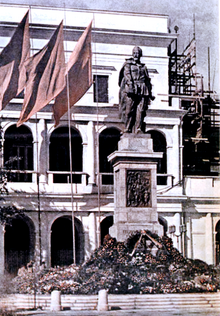Bank Square, Warsaw



Plac Bankowy (in English: 'Bank Square') in Warsaw is one of that city's principal squares. Located downtown, adjacent to the Saxon Garden and Warsaw Arsenal, it is also a principal public-transport hub, with bus and streetcar stops and a Warsaw Metro station.
History
Created in the 19th century, under the Congress Kingdom, the square was designed to be an elegant area of the country's capital. Notable buildings included the Palace of the Ministry of Revenues and Treasury (a building reconstructed by Antonio Corazzi), the Bank of Poland and the Warsaw Stock Exchange (also by Corazzi). The square was originally triangular-shaped.[1]
Between 1875 and 1878 the Great Synagogue was built on the eastern side of the square, across from the palace. At the time of its building, it was the largest synagogue in Warsaw and one of the largest in the world. After the Warsaw Ghetto Uprising in 1943, the Nazi occupiers blew up the building, destroying it.
In the 1944 Warsaw Uprising, the remaining buildings on the square were destroyed. After the war, city planners reconstructed only its historic western part, changing it into a rectangle.[1] The synagogue was not rebuilt and currently in the same location is the Błękitny Wieżowiec office building.
Under the communist Polish People's Republic, the square was renamed Plac Dzierżyńskiego (Dzierżyński's Square) after Feliks Dzierżyński, a Polish-born communist politician and founder of the communist Russian Cheka political police. In 1951 a monument to Dzierżyński was erected in the southern part of the square. Four decades later, in 1989, the statue's toppling helped mark the fall of communism in Poland.
Today
Bank Square's present-day landmarks include Błękitny Wieżowiec (the Blue Skyscraper), and the former seat of the Ministry of Treasury now serves as Warsaw's city hall, the seat of the President of Warsaw and the provincial office of the Mazovia province.
In 2001 a monument to Juliusz Słowacki, by Edward Wittig, was erected on the spot previously occupied by the statue of Feliks Dzierżyński. The monument to Juliusz Słowacki is close to now removed Dzierżyński's statue's pedestal.
References
- ^ a b Plac Bankowy at the official website of Śródmieście district
52°14′35″N 21°0′8″E / 52.24306°N 21.00222°E
